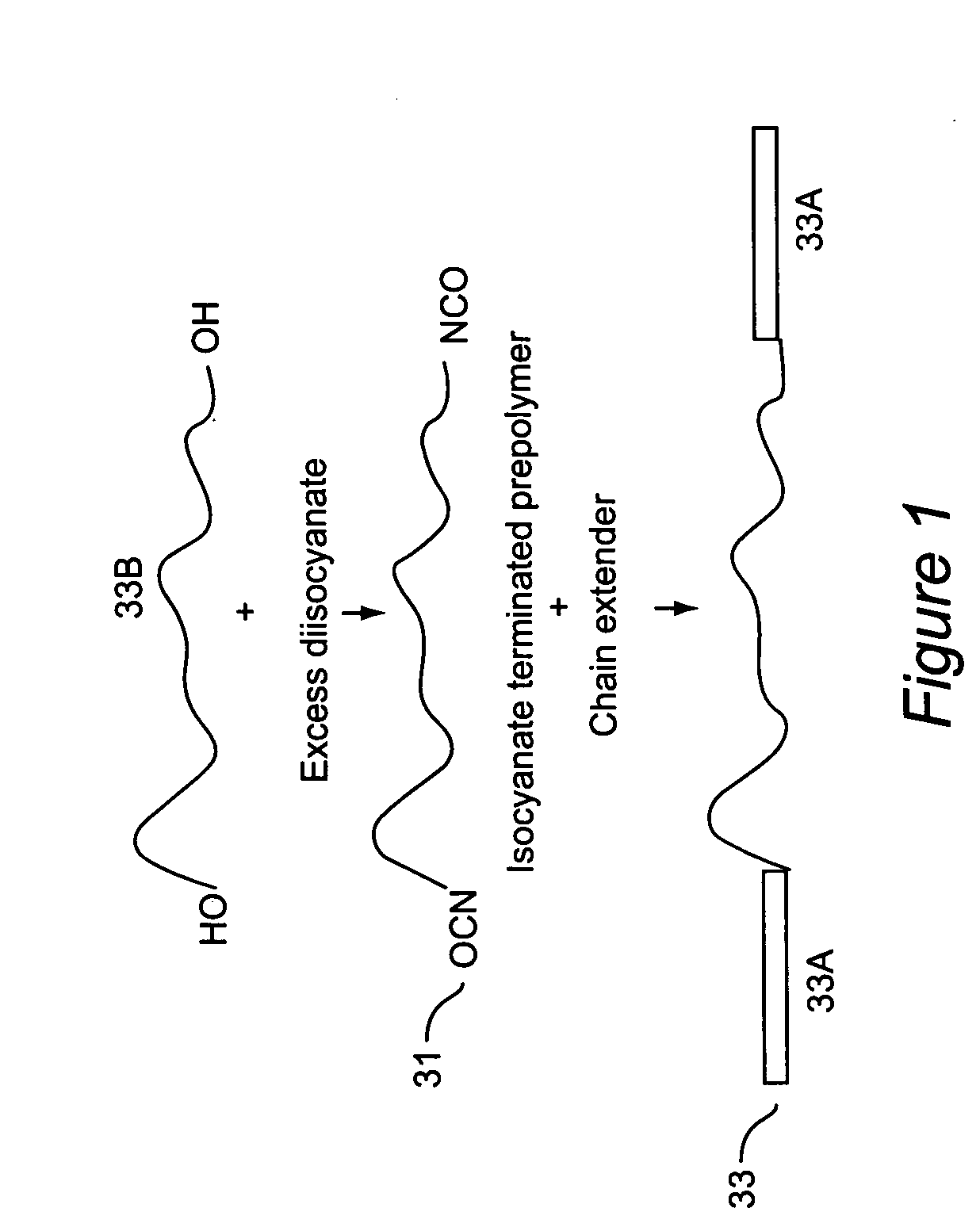Triblock copolymers and their production methods
a technology of copolymer and copolymer, applied in the field of triblock copolymer, can solve the problems of conventional thermoplastic polyurethane, polyurethane and polyurea technology, which has been limited to segmentation so far
- Summary
- Abstract
- Description
- Claims
- Application Information
AI Technical Summary
Problems solved by technology
Method used
Image
Examples
example 1
Preparation of Polyurea-Poly(ethylene oxide)-Polyurea triblock copolymer
[0038] 10.00 g (0.50 mmol) of poly(ethylene oxide)glycol with number average molecular weight (Mn) of 20,000 g / mol (PEO-20k) was introduced into a 250 mL, three-neck, round bottom flask fitted with an overhead stirrer, nitrogen inlet and addition funnel. 1.58 g (6.02 mmol) of bis(4-isocyanatocyclohexyl)methane (HMDI) was also introduced into the reactor and mixture was heated to 80° C., which formed a clear, homogeneous melt. One drop of a 1% dibutyltin dilaurate (T-12) solution in toluene was added as catalyst. After 1 hour of reaction, FTIR spectroscopy showed the completion of prepolymer reaction. Prepolymer was dissolved in 16.50 g of dimethylformamide (DMF) and the solution was cooled down to room temperature. 0.58 g (4.99 mmol) 2-methyl-1,5-diaminopentane (DYTEK) and 0.0700 g (0.96 meq) n-butylamine (BuA) were weighed into an Erlenmeyer flask, dissolved in 15.00 g of isopropanol (IPA) and introduced into ...
example 2
Preparation of a Polyurea-Polyalkane-Polyurea triblock copolymer
[0039] 13.58 g (4.07 mmol) of hydroxyl terminated liquid Kraton oligomer, which has a backbone composed of ethylene-propylene random copolymer and Mn value of 3,340 g / mol and 4.25 g HMDI (16.20 mmol) were weighed into a three-neck, 250 mL round bottom flask fitted with an overhead stirrer, nitrogen inlet and addition funnel. Mixture was heated to 80° C., which formed a clear, homogeneous melt. One drop of a 1% dibutyltin dilaurate (T-12) solution in toluene was added as catalyst. After 1 hour of reaction, FTIR spectroscopy showed the completion of prepolymer reaction. Prepolymer was dissolved in 27.80 g of tetrahydrofuran (THF) and the solution was cooled down to room temperature. 1.16 g (9.98 mmol) DYTEK and 0.31 g (4.25 meq) n-butylamine (BuA) were weighed into an Erlenmeyer flask, dissolved in 17.40 g of isopropanol (IPA) and introduced into the addition funnel. DYTEK+BuA solution was added into the reactor dropwise...
example 3
Preparation of a Polyurea-Polydimethylsiloxane-Polyurea triblock copolymer
[0040] 1.05 g (4.00 mmol) of HMDI was introduced into a 250 mL, three-neck, round bottom flask fitted with an overhead stirrer, nitrogen inlet and addition funnel and dissolved in 18.50 g IPA. 10.89 g of α-ω-aminopropyl terminated polydimethylsiloxane oligomer (PDMS) with Mn=11,800 g / mol was weighed into an Erlenmeyer flask, dissolved in 27.30 g IPA and introduced into the addition funnel. PDMS solution was added into the reactor dropwise at room temperature. 0.23 g DYTEK (1.98 mmol) was dissolved in 18.40 g of IPA and added into the reactor. 0.15 g (2.05 meq) of BuA was dissolved in 12.00 g IPA and added into the reaction mixture dropwise to cap the isocyanate end groups. Completion of reactions at each step was monitored by FTIR spectroscopy. A film was cast on a Teflon mold; solvent was first evaporated at room temperature overnight, then in a 60° C. oven and finally in a vacuum oven at 60° C. until consta...
PUM
| Property | Measurement | Unit |
|---|---|---|
| Fraction | aaaaa | aaaaa |
| Fraction | aaaaa | aaaaa |
| Fraction | aaaaa | aaaaa |
Abstract
Description
Claims
Application Information
 Login to View More
Login to View More - R&D
- Intellectual Property
- Life Sciences
- Materials
- Tech Scout
- Unparalleled Data Quality
- Higher Quality Content
- 60% Fewer Hallucinations
Browse by: Latest US Patents, China's latest patents, Technical Efficacy Thesaurus, Application Domain, Technology Topic, Popular Technical Reports.
© 2025 PatSnap. All rights reserved.Legal|Privacy policy|Modern Slavery Act Transparency Statement|Sitemap|About US| Contact US: help@patsnap.com



